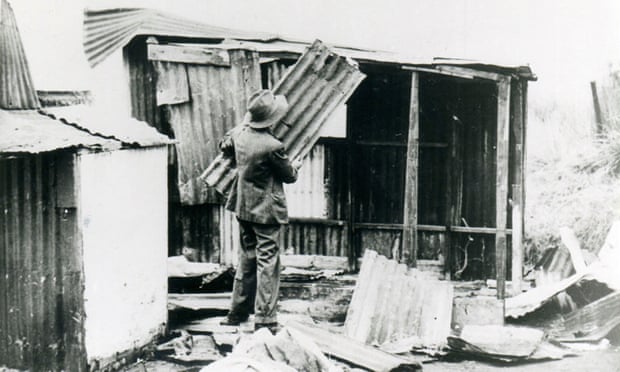Extract from The Guardian
In the 1930s large camps of homeless people dotted Australian cities and towns. It was a different scale to our housing problems now, but it raises similar questions.

The coast at La Perouse, near the New South Wales Golf Club, was the site of Happy Valley, a shanty town that was the last resort for more than 300 people at the height of the Great Depression. It was a place littered with huts and tents made of whatever people could lay their hands on — iron sheeting, hessian bags coated in limewash, scavenged wood. Families took up a patch of sand between the bush and other shacks, and often stayed for years.
Before it was dismantled in 1939 and the residents moved on, Happy Valley was one of the biggest communities of homeless people during the Depression. There was a donated marquee for dances and an oval for sport. Close relationships were reportedly formed with residents of the nearby Aboriginal mission. Children in hand-sewn clothes played in the tight lanes between huts. Food was scrounged one way or another.
This was life for thousands of Australians during the worst economic crisis in our history. I remember hearing stories of the Great Depression growing up. My pop was one of 13 children. He had to catch rabbits near his home in inner-city Perth to help feed the family. Many others had it as bad or worse.

Unaffordable housing. Struggling to make ends meet. People living in makeshift shelters. Does this sound familiar?
Happy Valley and the other camps of the Depression bear more than a passing resemblance to recent reports of more and more people being forced out of unaffordable houses or unable to secure a rental in the tight markets around Australia. Many regions are seeing rental vacancy rates lower than 1%. Social housing demand is far higher than supply. And so, families displaced by natural disasters or rents they can’t afford are living in tents, people are going hungry to try to hold onto their homes, and couples are making a bed out of the backseat of a car.
What happens in a society when the gap between rich and poor widens? Who do we blame in a crisis?
The housing crisis of the Depression was more severe, and the people it affected did not have access to the welfare services available today, however inadequate they can be. There may not be enough social housing today, but there is some. We’re not seeing tin towns dotted around our capital cities, and the number of people in desperate circumstances is far lower than in the 1930s. They are different and unique crises, but they raise similar questions.
What happens in a society when the gap between rich and poor widens? How do we treat the displaced who end up in the unused spaces around our cities and towns? Who do we blame in a crisis? Who holds out a hand, and who raises a fist?
In short, before World War II came to bind the nation in a common cause, it led to widespread unrest. In 1932, tensions over unemployed men camping in the Cairns showgrounds boiled over into a battle between the itinerant men and locals that left around 80 people injured, many seriously. The streets of Brunswick, Newtown, Port Adelaide, Fremantle and many more neighbourhoods became the front lines in fights between evicted tenants, their supporters and the authorities. It was not unusual to see localised rioting when a family was pushed out of their home, their possessions piled around them in the street. In 1931, the windows of almost every estate agent’s office in Richmond and Burnley were smashed. In Bankstown the same year, protestors occupied a house set for eviction and used barbed wire to try to hold off the police before a fight involving stones and bricks and bullets.
In the decades after the Depression, successive governments introduced or increased access to measures such as social housing, unemployment benefits and higher education. But recent governments have allowed most of these measures to slide back into inadequacy.
There are, obviously, many differences between then and now. For one, the people living in tents and sleeping in cars in 2022 often have jobs. In the 1930s, there was a deep recession and high unemployment. Now, there’s rising inflation, stagnant wages and scarce housing. Then, like now, government interventions failed to keep pace with the crisis, and it was left to community and benevolent organisations to pick up the pieces. It’s a matter of details and scale.
We’ve learned some lessons since the Great Depression. In 2020, JobKeeper kept people out of dole queues and eviction moratoriums helped renters stay in their homes, but we have not seen the broad-scale reforms of the type that made post-Depression Australia more fair.
What remains to be seen is how – if our current crisis worsens and more people are forced out of stable accommodation – we will respond.
The question for us now is: What echoes will future generations hear from our time?
Sean Wilson is the author of Gemini Falls (Affirm Press), out 27 September.
No comments:
Post a Comment